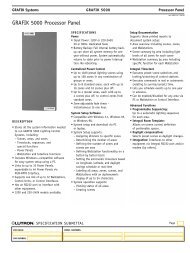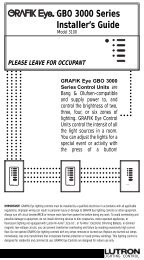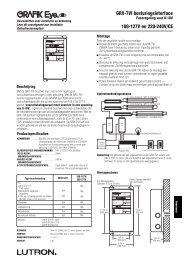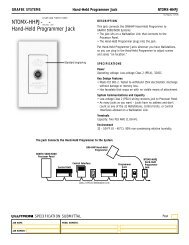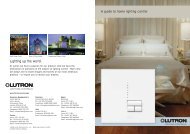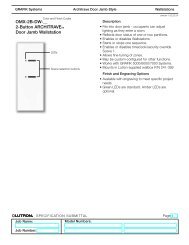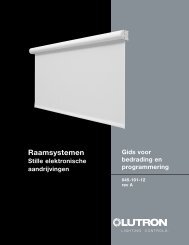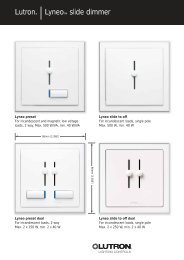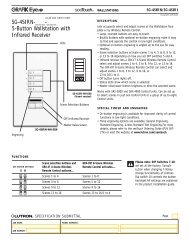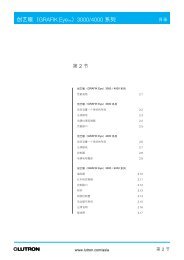Create successful ePaper yourself
Turn your PDF publications into a flip-book with our unique Google optimized e-Paper software.
<strong>Power</strong> <strong>Panels</strong>Table of contentsSection 4Introduction 4.1Performance specifications 4.2Overview 4.3Custom combination panels 4.4GP dimming panels 4.5LP dimming panels 4.6XP switching panels 4.7Application notes 4.8Wiring diagrams 4.9www.lutron.comSection 4
<strong>Power</strong> <strong>Panels</strong>IntroductionPre-assembled dimming and switching panelsPre-AssembledDimming and Switching <strong>Panels</strong><strong>Lutron</strong>’s dimming and switching panels provide thepower behind the GRAFIK systems line of products.A variety of panels are available to meet theperformance and budget requirements of any project.<strong>Power</strong> panels have been designed to workindependently or combined together to meet therequirements of any project.<strong>Lutron</strong>® can also further customise individual panels.ELV dimming moduleTVM moduleAdaptive dimming moduleLP dimming moduleMotor moduleXP switching moduleCustom combination panelCustom dimming/switching paneltailored to your project’s requirements.4.1.1 www.lutron.com
<strong>Power</strong> <strong>Panels</strong>IntroductionPre-assembled dimming and switching panelsXP Softswitch panelMillion-cycle switching panelemploys <strong>Lutron</strong>’s patentedSoftswitch technology.LP dimming panelCommercial dimming panel forhandling numerous small loads.GP dimming panel<strong>Lutron</strong>’s highest performance architecturaldimming panel for all applications.www.lutron.com4.1.2
<strong>Power</strong> <strong>Panels</strong>Performance SpecificationReal-Time Illumination Stability System (RTISS )Dimmers compensate for incoming line voltage variations such as changes inRMS (Root Mean Square) voltage, frequency shifts, harmonics, and line noise.See the application note on pg. 4.8.6 for more information.Real-Time Illumination Stability System–trailing edge(RTISS-TE )Trailing edge (reverse phase control) dimmers equipped with the new RTISS-TEtechnology protect against power conditions that cause lights controlled bystandard toggle switches to flicker. See the application note on pg. 4.8.9 formore information.The benefitsFlicker-free dimmingThe benefitsFlicker-free dimmingA. Expected power provided to the dimmer B. Poor quality power caused by line sag.ProductsCustom Combination <strong>Panels</strong>, GP, LPC. RTISS-TE compensates for the line sag byconducting longer (darker section).D. The actual RTISS-TE power outputwhen the line sags is the same as theexpected power.Note. RTISS-TE provides a similar reponse due to a line surge by conducting for a shorter periodof time.ProductsCustom combination panels, GP, LPRecommended specificationsDimmer loads shall have no visible flicker by checking for changes 100 timesper second (120 times per second at 60 Hz) under the following conditions:±2% change in RMS voltage per cycle and or ±2% rate of change in frequencyper second.ProductsCustom combination panelsRecommended specificationsDimmers shall maintain constant power (±2%) to the load by checking forchanges 100 times per second (120 times per second at 60 Hz) under thefollowing conditions: ±10% change in RMS voltage per cycle and or ±2% rateof change in frequency per second.4.2.1 www.lutron.com
<strong>Power</strong> <strong>Panels</strong>Performance Specification1,000,000 cycle switching modules Convection cooling<strong>Lutron</strong>’s exclusive Softswitch circuitry opens and closes the relay contactswithout arcing. See the application note on pg. 4.8.12 for more information.<strong>Panels</strong> are cooled naturally via air convection.The benefitsEven when fully loaded, the arc reduction extends a relay’s average rated life tomore than 1,000,000 on/off cycles.The benefitsNo fan to worry about failing, no filters to replace, no maintenance.LiveRelayMechanicallyheldLOAD CURRENTRelayElectronicallyheldLiveRelayMechanicallyheldLOAD CURRENTRelayElectronicallyheldSwitchedliveATriacSolid statedeviceSwitchedliveBTriacSolid statedevicePanelLOAD CURRENTLOAD CURRENTLiveRelayMechanicallyheldRelayElectronicallyheldLiveRelayMechanicallyheldRelayElectronicallyheldSwitchedliveTriacSolid statedeviceSwitchedliveTriacSolid statedeviceCDProductsCustom combination panels, XPRecommended specificationsSwitching modules shall:1. Be operated in a manner that ensures no arcing will occur at the mechanicalcontacts when power is applied to or removed from the load circuits.2. Have a minimum rated lifetime of 1,000,000 cycles at 16 A.3. Maintain an open air gap when in the off state.4. Switch semiconductor out of circuit to ensure highest efficiency.ProductsCustom combination panels, GP, LP, XPRecommended specificationsDimmers/modules shall be cooled naturally via air convection.www.lutron.com4.2.2
<strong>Power</strong> <strong>Panels</strong>Performance SpecificationAir gap offLightning strike surge protectionAn air gap is provided in each module.Special circuitry protects the modules from surges.The benefitsWithout this, the leakage current of the module may cause electrical shock whenservicing lamps or a fire if a fixture or lamp source fails violently.The benefitsProtects your modules from power surges during a storm (or from withinthe building).ProductsCustom combination panels, GP, LP, XPRecommended specificationsModules shall have an air gap to totally disconnect power from the load sothat no leakage current shall be present at the fixture(s) when all outputs arein the off state.ProductsCustom combination panels, GP, LP, XPRecommended specificationsDimmers/modules shall meet IEEE standard c62.41, tested towithstand voltage surges of up to 6,000 volts and 3,000 amps.Dimmers/modules shall meet IEC 61000-4-5 surge requirements.4.2.3 www.lutron.com
<strong>Power</strong> <strong>Panels</strong>Performance SpecificationDistributed intelligenceEmergency modeEach dimmer or module has its own microprocessor that tells it how bright thelights shoud be.The benefits<strong>Lutron</strong>’s tiered intelligence architecture is better suited to keeping your lights attheir current light level in the unlikely event of a failure at a higher level in thesystem providing; multiple levels of redundancy.Selected circuits go to full-on when normal power fails either automatically (seethe application note on pg. 4.8.4), or manually (by cycling power to the dimmeror module).The benefitsYou won’t be in the dark during emergencies.ProductsCustom combination panels, GP, LP, XPRecommended specificationsDimmers/modules shall have dimming/switching intelligence at thedimmer/module level.ProductsCustom combination panels, GP, LP, XP.Recommended specificationsDimmers/modules shall go to full-on mode when power to the dimmer/module iscycled without a control input or with a loss of normal power.www.lutron.com4.2.4
<strong>Power</strong> <strong>Panels</strong>Performance SpecificationSmooth and continuous dimmingInrush currentSmooth and continuous lighting control across the dimming range.Switching modules are designed to withstand inrush of 50 times operatingcurrent.The benefitsStep-free continuous lighting control; sudden steps in light level are eliminated.The benefitsSwitching modules last longer and do not fail under high inrush conditions suchas bulb burnouts and switching electronic fluorescent ballasts on.InrushSteady stateProductsCustom combination panels, GP, LPRecommended specificationsDimmers shall provide smooth and continuous control of light intensity witha minimum of 4,056 steps or light levels.ProductsCustom combination panels, XPRecommended specificationsSwitching modules shall withstand an inrush of 50 times operating current.4.2.5 www.lutron.com
<strong>Power</strong> <strong>Panels</strong>Performance Specification<strong>Power</strong> failure memoryWorld-class quality processKeeps lights as you left them when power is restored.For over 40 years, <strong>Lutron</strong>® has designed, manufactured, and delivered qualitylighting control products.The benefitsMinimises the inconvenience of power service interruptions by returning lightsto previous level.The benefitsReliable product quality, dependable service, and continual innovation.CustomerfeedbackInnovativeproduct designRigorous laband field testingDependablesales andcustomerserviceFinished goodsquality audits100% end-oflineproductttestingOngoingprocessimprovementsIn-processinspectingQualitysuppliersselectedIncomingcomponentinspectionProductsCustom combination panels, GP, LP, XPRecommended specificationsDimmers/modules shall incorporate power-failure memory. Should power beinterrupted and subsequently returned, the lights will come back on to the samelevel set prior to the power interruption. Restoration to some other default levelis not acceptable.ProductsAllRecommended specificationsManufacturer shall be <strong>Lutron</strong> Electronics. Manufacturer shall be at leastISO 9001:2000 registered.www.lutron.com4.2.6
<strong>Power</strong> <strong>Panels</strong>Overview<strong>Lutron</strong>® power panels are compatible with the following systems:SourcesGRAFIK Eye 4000 series, section 2.6DimmingpanelsSwitching panelsGRAFIK Eye control units Wallstations ControlinterfacesWindow treatment controllers and wallstationsControl station devicesSourcesCentralised lighting control system, section 3EthernetinterfaceUser interfacejackProcessorpanelsDimming panelsSwitchingpanelsLaptopViseo Wallstations ControlinterfacesControl Station DevicesWindowtreatmentcontrollersContact <strong>Lutron</strong> for additional sales and technical literature, or visit www.lutron.com.4.3.1 www.lutron.com
<strong>Power</strong> <strong>Panels</strong>Overview<strong>Power</strong> booster or power panel?There are specific system requirements that could lead to designing with eitherapproach. Factors that need to be examined include:Simplicity of designDeciding on an approach is a matter of personal design preferences. A projectmay require additional interfaces solely because of the chosen lighting sourcesor may require power boosters for higher wattages. A GP power panel can handlevirtually any load type without additional interfaces.Entertainment DMX512 options2Link The 2Link option provides two distinct control links inside each power panel. Eachlink—Link A and Link B—is capable of operating on any one of these systems –<strong>Lutron</strong>’s GRAFIK Eye 4000, <strong>Lutron</strong>’s centralised lighting control system, orUSITT DMX512 protocol. Each system or protocol is unique, but the power panelis designed to automatically detect which one is present and operate accordingly.When ordering the appropriate panel, ask for the 2Link option.Space for equipmentIf power boosters/interfaces can be located throughout the building, it may be thepreferred approach. If all power boosters/interfaces are located in the sameelectrical room, a power panel will typically require less space. <strong>Power</strong> panels mayalso include branch circuit breakers, reducing the size of the lighting distributionpanel or eliminating it altogether.Link AGRAFIK Eye 4000 controlLink BJackEmergencyOne of the circuits may need to be an emergency circuit. If using an upstreammain transfer switch (i.e., 100 A, 3P), a power panel solution is the better choice.<strong>Lutron</strong> also offers an emergency lighting interface to sense loss of voltage on asingle or multi-phase system in 220-240 V (non-CE) applications. See the applicationnote on pg. 4.8.5 for more information.GP dimming panelInstallation timeA power panel will require less time to install than numerous power boosters.DMX stage consoleAcoustic performanceGRAFIK Eye Designer softwareLamp Noise SuppressionGP dimming panels provide the highest level of lamp noise suppression for:• high wattage situations• incandescent sources• halogen sources• extremely quiet ambient environmentsLamp debuzzing coils (LDC) can be added to power boosters to provide the sameperformance. See the application note on pg. 4.8.2 for more information.Want system design time to be two to four times faster? <strong>Lutron</strong>’s GRAFIK EyeDesigner software automatically assigns boosters/interfaces or dimmingpanels, removing any guesswork when designing a system. Consult <strong>Lutron</strong> orvisit www.lutron.com/designer for more information.www.lutron.com4.3.2
<strong>Power</strong> <strong>Panels</strong>Custom Combination <strong>Panels</strong>Custom combination panels are built-to-order to provide the following capabilitieson a project-by-project basis:• Dimming modules for incandescent (tungsten)/halogen, magnetic low voltage, neon/cold cathodesources also switch 0-10 V, DALI, or DSI loads• Dimming modules for electronic low-voltage sources• Switching modules for all sources• Control Modules for operating 0-10 V, DALI (broadcast only), or DSI loads• Motor Modules for 3-wire AC motorised window treatmentsModules listed above can be combined into one panel.Contact <strong>Lutron</strong>® for possible module combinations thatwill meet the specific needs of your project.Custom combination panelsSourcesDesign optionsIncandescentMagnetic low voltageElectronic low voltageFluorescentNeon/cold cathodeHigh-intensity dischargeMotor• Input feed – input breaker, isolator switch,feed-through• Branch breakers – 10 A, 13 A, or 16 A• Panel voltage – 220 V-240 V, 230 V (CE)• Operates on 50 Hz or 60 Hz power• Panel feed – single-phase or three-phase• 2Link option – provides a second control linkthat automatically detects the presenceof a DMX512 stage consoleSpecifications• All voltages indicated are phase-to-neutral• Operates on 50 Hz or 60 Hz power• Can control most popular load sources• Common neutrals are not permitted;run separate neutrals for each control load• <strong>Panels</strong> may be in the middle of a GRAFIK Eye4000 control link; control link must be daisychained• System can include a combination of GP, LP,XP, and custom combination <strong>Panels</strong>• <strong>Power</strong> panel installation instructions areavailable in multiple languages; contact <strong>Lutron</strong>or visit www.lutron.com for more informationMounting• Indoor use only; IP-20 protection• Panel generates heat; mount only where ambienttemperature will be 0-40º C (32-104º F) witha non-condensing relative humidity < 90%• <strong>Panels</strong> must mount within 7º of true verticalUP-7˚ +7˚Mount panelverticallyStandardsStandards listed below apply to one ormore products in the <strong>Lutron</strong> product line.Consult <strong>Lutron</strong> for specific information.SystemsGRAFIK Eye 4000 series, section 2.6Centralised lighting controlsystem, section 34.4.1 www.lutron.com
<strong>Power</strong> <strong>Panels</strong>Noteswww.lutron.com4.4.2
<strong>Power</strong> <strong>Panels</strong>Specifying Custom Combination <strong>Panels</strong>Step 1: Select modules based on load requirementsNEW Adaptive moduleSourcesIncandescentMagnetic low voltageElectronic low voltageNeon/cold cathodeNEW• Manual or automatic selection between leadingedge or trailing edge dimming• One input and four outputs per module• Maximum loads (CE and non-CE):8 A per output13 A continuous total per module• Maximum 100 BTUs/hourWith NEW RTISS-TE technologyLP dimming moduleSourcesIncandescentMagnetic low voltageElectronic low voltage*Fluorescent**Neon/cold cathodeNon-dim for above load types• One input and four outputs per module• Maximum loads (CE):10 A per output13 A continuous total per module• Maximum loads (non-CE):16 A per output16 A continuous total per module• Maximum 80 BTUs/hour* Requiring <strong>Lutron</strong>® low voltage transformer.** Switched loads w/TVM modules.ELV dimming moduleSourcesIncandescentElectronic low voltage• One input and four outputs per module• Maximum loads (CE and non-CE):10 A per output16 A continuous total per module• Maximum 100 BTUs/hour4.4.3 www.lutron.com
<strong>Power</strong> <strong>Panels</strong>Specifying Custom Combination <strong>Panels</strong>Step 1: continuedTVM moduleSourcesFluorescent• Each module controls two consecutive dimminglegs of lighting for 0-10 V, DALI (broadcastintensity only), DSI ballasts, or PWM ballasts• For every two TVM Modules one LP Dimming orXP switching module MUST be present• 50 mA maximum low voltage ballast controlcurrent per dimming leg• 750 mA maximum low voltage ballast controlcurrent per panel• Sinks and sources current• 2 outputs per moduleXP Switching moduleSourcesIncandescentMagnetic low voltageElectronic low voltage• Switches all lighting sources• Four inputs and four outputs• Softswitch technology (see pg. 4.8.12)• Maximum load: 16 A per output• Maximum 5 BTUs/hourFluorescentNeon/cold cathodeHigh intensity dischargeMotor moduleSourcesAC Motors• One input and four dual outputs• Controls up to four three-wire AC motors• Maximum load per motor module is 16 A• Maximum load per AC motor is 5 Awww.lutron.com4.4.4
<strong>Power</strong> <strong>Panels</strong>Specifying Custom Combination <strong>Panels</strong>Step 2: select an enclosure styleSmall enclosureFeed type TVM Adaptive LP ELV Motor XPFeed-through NA Any combination up to 3 modulesFeed-through 0-4 Any combination up to 2 modulesInput breakers NA Any combination up to 3 modules 0Input breakers 0-4 Any combination up to 2 modules 0DimensionsW: 404 mm (15.88”)H: 622 mm (24.50”)D: 108 mm (4.25”)Large enclosureFeed type TVM Adaptive LP ELV Motor XPFeed-through 0-12 Any combination up to 8 modulesInput breakers 0-12 Any combination up to 8 modules 0Input breakers 0-12 Any combination up to 6 modulesNotes• For every two TVM modules, one LP dimming or XP switching module MUST be present.• Consult <strong>Lutron</strong>® for panels with custom breaker needs.• TVM = 0 is a TVM-ready panel; TVM modules can easily be installed in the future.• TVM = NA is not TVM-readyDimensionsW: 404 mm (15.88”)H: 1512 mm (59.50”)D: 108 mm (4.25”)4.4.5 www.lutron.com
ON<strong>Power</strong> <strong>Panels</strong>Specifying Custom Combination <strong>Panels</strong>Step 3: select input breakerA: Feed-through panel, no breakersB: Single pole input breakers –10, 13 and 16 A available;6000 AIC Rating; Type CC: Consult <strong>Lutron</strong>® for otherbreaker optionsDimensions - singlepole breakersW: 17.6 mm (0.69”)H: 81.4 mm (3.20”)D: 65.0 mm (2.55”)Step 4: select circuit selectorA: One-Link (Standard) circuit selectorB: The 2Link option provides two distinct control links inside each power panel. Each link – Link Aand Link B – is capable of operating on any one of these systems: <strong>Lutron</strong>’s GRAFIK Eye 4000,<strong>Lutron</strong>’s centralised lighting system control, or USITT DMX 512 protocol. Each system or protocolis unique, but the power panel is designed to automatically detect which one is present and operateaccordingly.Link ALink BJackGRAFIK Eye 4000 controlGP dimming panelDMX stage consoleStandardsStandards listed below apply to one ormore products in the <strong>Lutron</strong> product line.Consult <strong>Lutron</strong> for specific information.www.lutron.com4.4.6
<strong>Power</strong> <strong>Panels</strong>GP Dimming <strong>Panels</strong>Mini GP (3,4)High-performance architectural dimming• <strong>Lutron</strong>’s patented filter circuit, RTISS –Real-Time Illumination Stability System,compensates for incoming line-voltage variations and maintains constant light levels with no visibleflicker under conditions with a ±2% change in RMS voltage/cycle and a ±2 Hz change infrequency/second; for more information, see application note on pg. 4.8.6 for more information• Offered in two cabinet sizes containing from 3-24 circuits• Preassembled panels, field wiring is similar to wiring lighting distribution panel• Filter chokes provide a rise time of at least 165 µsec at 50% dimmer capacity,measured from 10-90% of the load current waveform at 90% conduction angle and at no point fasterthan 60 mA/µsec• Custom panels available if needs are beyond 24 circuits; contact <strong>Lutron</strong>®Loading Measurement limits Current rise time50% 10-90% 165 µsec50% 0-100% 250 µsec100% 10-90% 195 µsec100% 0-100% 290 µsecHigher rise times are available up to 400 µsec; contact <strong>Lutron</strong> for details.GP8-24SourcesIncandescentMagnetic low voltageElectronic low voltage(leading edge only)FluorescentNeon/cold cathodeHigh-intensity discharge(non-dim)Specifications• All voltages indicated are phase-to-neutral• Operates on 50 Hz or 60 Hz power• Can control most popular load sources• Common neutrals are not permitted;run separate neutrals for each control load• <strong>Panels</strong> may be in the middle of a GRAFIK Eye4000 control link; control link must be daisychained• System can include a combination of GP, LP,XP, and Custom Combination <strong>Panels</strong>• <strong>Power</strong> Panel installation instructions areavailable in multiple languages; contact <strong>Lutron</strong>or visit www.lutron.com for more informationStandardsStandards listed below apply to one ormore products in the <strong>Lutron</strong> product line.Consult <strong>Lutron</strong> for specific information.Design Options• Input feed – feed-through, isolator switch• Branch breakers – 10 A (CE), 16 A (non CE)• Panel voltage – 220 V-240 V, 230V (CE)• Operates on 50 Hz or 60 Hz power• Panel feed – single-phase or three-phase• Number of circuits: 3-24• 2Link option – provides a second control linkthat automatically detects the presenceof a DMX512 stage console• Custom panels available if needs are beyond24 circuits; contact <strong>Lutron</strong>.• Review requirements with <strong>Lutron</strong>. Some fluorescentloads require an interface or a custom panel.Mounting• Indoor use only; IP-20 protection• Panel generates heat; mount only where ambienttemperature will be 0-40º C (32-104º F) witha non-condensing relative humidity < 90%• Surface-mount only• <strong>Panels</strong> must mount within 7º of true verticalSystemsGRAFIK Eye 4000 Series, section 2.6UP-7˚ +7˚Centralised Lighting ControlSystem, section 3Mount panelvertically4.5.1 www.lutron.com
<strong>Power</strong> <strong>Panels</strong>GP Dimming <strong>Panels</strong>Source3 or 4 circuits8 - 24 circuitsDimensionsGP8 - GP24W: 703 mm (27.65”)H: 997 mm (39.25”)D: 305 mm (12.00”)WeightGP8DimensionsGP3, 4W: 280 mm (11.00”)H: 546 mm (21.15”)D: 159 mm (6.25”)Wt:14 kg (30 lbs)Ship wt: 19 kg (40 lbs)Max. BTUs/hr: 685(kcal/hr: 172.7)Wt: 52 kg (115 lbs)Ship wt: 75 kg (165 lbs)Max. BTUs/hr: 1365 (kcal/hr: 343.98)GP12Wt: 60 kg (130 lbs)Ship wt: 82 kg (180 lbs)Max. BTUs/hr: 2045 (kcal/hr: 515.34)GP16Wt: 66 kg (145 lbs)Ship wt: 88 kg (195 lbs)Max. BTUs/hr: 2725 (kcal/hr: 686.70)GP20Wt: 73 kg (160 lbs)Ship wt: 95 kg (210 lbs)Max. BTUs/hr: 3405 (kcal/hr: 858.06)GP24Wt: 80 kg (175 lbs)Ship wt: 102 kg (225 lbs)Max. BTUs/hr: 4085 (kcal/hr: 1,029.42)TypeGP3GP4GP8GP12GP16GP20GP24Model No. PrefixNo. of CircuitsVoltageFeed Type 1Isolator Switch (IS)Region Suffix 2Branch Circuit BreakerCapacity(A)Available model numbers (Model No. Example: GP12-2304IS-10CE)• Custom panels available if needs are beyond 24 circuits; contact <strong>Lutron</strong>®.Maximum Panel Feed (A)GP 3- 230 4 M- 3 10 CE N/A 2300GP 3- 240 4 M- 3 16 AU N/A 3840GP 4- 230 FTML CE N/A 2300GP 4- 240 FTML AU N/A 3840GP 8- 230 2 IS- 10 CE 125 2300GP 8- 230 4 IS- 10 CE 125 2300GP 8- 240 2 IS- 10 AU 125 2400GP 8- 240 2 IS- 16 AU 125 3840GP 8- 240 4 IS- 10 AU 125 2400GP 8- 240 4 IS- 16 AU 125 3840GP 12- 230 4 IS- 10 CE 125 2300GP 12- 240 4 IS- 10 AU 125 2400GP 12- 240 4 IS- 16 AU 125 3840GP 16- 230 4 IS- 10 CE 125 2300GP 16- 240 4 IS- 10 AU 125 2400GP 16- 240 4 IS- 16 AU 125 3840GP 20- 230 4 IS- 10 CE 125 2300GP 20- 240 4 IS- 10 AU 125 2400GP 20- 240 4 IS- 16 AU 125 3840GP 24- 230 4 IS- 10 CE 125 2300GP 24- 240 4 IS- 10 AU 125 2400GP 24- 240 4 IS- 16 AU 125 3840Maximum DimmedLoad (W/VA)per circuitFootnotes, pg. 4.5.21 Feed types–phase-to-neutral only. 2=1Ø,2 W; 4=3Ø,4 W; FTML= Feed Through2 Region suffix: CE= Europe; AU=Asia or 240V Latin America, or Africa3 Input feed terminates at branch breaker(s)4 The feed type of a GP3 panel is designated as a 4, which is 3Ø, 4 W. These panels can be wired as1Ø, 2 W with a 50 A max. feed, or 1Ø, 3 W with a 40 A max. feed.Note<strong>Panels</strong> listed above are <strong>Lutron</strong> standard panels. Consult <strong>Lutron</strong> for additional capabilities, such as job-specificcircuit requirements, 0-10 V, 2Link , etc.www.lutron.com4.5.2
<strong>Power</strong> <strong>Panels</strong>LP Dimming <strong>Panels</strong>Commercial dimming panel for numerous small loads• <strong>Lutron</strong>’s patented filter circuit, RTISS –Real-Time Illumination Stability System, compensates forincoming line-voltage variations and maintains constant light levels with no visible flicker underconditions with a ±2% change in RMS voltage per cycle and a ±2 Hz change in frequency persecond; see the application note on pg. 4.8.6 for more information• Preassembled panels, field wiring is similar to wiring lighting distribution panel• Four independently dimmed switch legs per module; up to eight modules (32 dimmers) per panelSourcesIncandescentMagnetic low voltageElectronic low voltage*Neon/cold cathodeSources requiring an interfaceor custom panelElectronic low voltage pg. 2.5.2Fluorescent 1* Requires <strong>Lutron</strong>® low voltage transformerLP dimming panelDesign options• Input feed – isolator switch• Branch breakers – 13 A (CE), 16 A (non-CE)• Panel voltage – 220 V-240 V, 230 V (CE)• Operates on 50 Hz or 60 Hz power• Panel feed – single-phase or three-phase• Number of switch legs: 4-32• 2Link option – provides a second control linkthat automatically detects the presenceof a DMX512 stage consoleMounting• Indoor use only; IP-20 protection• Panel generates heat; mount only where ambienttemperature will be 0-40º C (32-104º F) witha non-condensing relative humidity < 90%• Flush or surface-mount• <strong>Panels</strong> must mount within 7º of true verticalUPSpecifications• All voltages indicated are phase-to-neutral• Each dimming module has four independentlydimmed switch legs, which share a commonair-gap switch• Common neutrals are not permitted;run separate neutrals for each control load• <strong>Panels</strong> may be in the middle of a GRAFIK Eye 4000 control link; control link must be daisychained• System can include a combination of GP, LP,XP, and custom combination <strong>Panels</strong>• <strong>Power</strong> panel installation instructions areavailable in multiple languages; contact <strong>Lutron</strong>®or visit www.lutron.com for more informationSystemsGRAFIK Eye 4000 series, section 2.6-7˚ +7˚Mini LPdimming panelMount panel verticallyCentralised lighting controlSystem, section 3StandardsStandards listed below apply to one ormore products in the <strong>Lutron</strong> product line.Consult <strong>Lutron</strong> for specific information.Footnotes, pg. 4.6.11 0-10 V refer to pg. 4.9.5 in the wiring diagrams section, for other loads contact <strong>Lutron</strong>.4.6.1 www.lutron.com
<strong>Power</strong> <strong>Panels</strong>LP Dimming <strong>Panels</strong>Source230 V (CE)/ 240 V (non CE)1- 8 dimming modulesDimensionsMini LP1, 2, 3W: 404 mm (15.88”) Wt: LP1 15 kg (33 lbs)H: 622 mm (24.50”) LP2 16 kg (35 lbs)D: 108 mm (4.25”) LP3 17 kg (37 lbs)Ship Wt adder for LP1, LP2, LP3: +1.4kg (3 lbs)LP1 Max. BTUs/hr: 90 (kcal/hr: 22.68)LP2 Max. BTUs/hr: 170 (kcal/hr: 42.84)LP3 Max. BTUs/hr: 250 (kcal/hr: 63.00)LP1LP2LP3LP4LP5LP6LP7LP8TypeModel No. PrefixNo. of Dimming ModulesVoltageNo. of Switch LegsFeed Type 1Input Breaker (M) 2Isolator Switch (IS)Branch Circuit BreakerCapacity (A)Maximum Panel Feed (A)230 V (CE)LP 1/ 4- 230 2 M- 2 13 N/A 3000240 V (non CE)LP 1/ 4- 240 2 M- 2 16 N/A 3840230 V (CE)LP 2/ 8- 230 2 M- 2 13 N/A 300O240 V (non CE)LP 2/ 8- 240 2 M- 2 16 N/A 3840230 V (CE)LP 3/ 12- 230 4 M- 2 13 N/A 300O240 V (non CE)LP 3/ 12- 240 4 M- 2 16 N/A 3840230 V (CE)LP 4/ 16- 230 4 IS- 13 125 300O240 V (non CE)LP 4/ 16- 240 4 IS- 16 125 3840230 V (CE)LP 5/ 20- 230 4 IS- 13 125 300O240 V (non CE)LP 5/ 20- 240 4 IS- 16 125 3840230 V (CE)LP 6/ 24- 230 4 IS- 13 125 300O240 V (non CE)LP 6/ 24- 240 4 IS- 16 125 3840230 V (CE)LP 7/ 28- 230 4 IS- 13 125 300O240 V (non CE)LP 7/ 28- 240 4 IS- 16 125 3840230 V (CE)LP 8/ 32- 230 4 IS- 13 125 300O240 V (non CE)LP 8/ 32- 240 4 IS- 16 125 3840Maximum DimmedLoad (W/VA)per moduleDimensionsLP4, 5, 6, 7, 8W: 404 mm (15.88”) Wt: LP4 25 kg (55 lbs)H: 1514 mm (59.50”) LP5 26 kg (57 lbs)D: 108 mm (4.25”) LP6 27 kg (59 lbs)LP7 28 kg (61 lbs)LP8 29 kg (63 lbs)Ship wt adder for LP4-LP8: +4.5kg (10 lbs)LP4 Max. BTUs/hr: 330 (kcal/hr: 83.16)LP5 Max. BTUs/hr: 410 (kcal/hr: 103.32)LP6 Max. BTUs/hr: 490 (kcal/hr: 123.48)LP7 Max. BTUs/hr: 570 (kcal/hr: 143.64)LP8 Max. BTUs/hr: 650 (kcal/hr: 163.80)Available model numbers (Model No. Example: LP5/20-2404IS-16)• Custom panels available• 230 V (CE) Model numbers if ordering within Europe:LP1/4-2302M-13 ➝ CCP-1L-2302M-1LLP2/8-2302M-13 ➝ CCP-2L-2302M-1LLP3/12-2304M-13 ➝ CCP-3L-2304M-1LLP4/16-2304IS-13 ➝ CCP-4L-2304IS-1LLP5/20-2304IS-13 ➝ CCP-5L-2304IS-1LLP6/24-2304IS-13 ➝ CCP-6L-2304IS-1LLP7/28-2304IS-13 ➝ CCP-7L-2304IS-1LLP8/32-2304IS-13 ➝ CCP-8L-2304IS-1LFootnotes, pg. 4.6.21 Feed types–phase-to-neutral only. 2= 1Ø,2 W; 4= 3Ø,4 W2 Input feed terminates at branch breaker(s)Note: <strong>Panels</strong> listed above are <strong>Lutron</strong> standard panels. Consult <strong>Lutron</strong> for additional capabilities,such as job-specific circuit requirements, 0-10 V, 2Link , etc.www.lutron.com4.6.2
<strong>Power</strong> <strong>Panels</strong>XP Switching <strong>Panels</strong>Million-cycle switching panel employs <strong>Lutron</strong>’s patented Softswitch technology• Patented Softswitch relay switches load with no arc. <strong>Lutron</strong>® has verified an average rated relay lifeof 1,000,000 cycles (on/off). See application note on page 185 for further details.LiveParallel switchmechanicallyheld relaySeries switchelectronically heldrelay• Pre-assembled panels, field wiring is similarto wiring lighting distribution panelSeries triacsolid state deviceSwitched liveXP SoftswitchFeed-through panel – 20-48 circuitsMini XP SoftswitchFeed-through panel – 4-16 circuitsSourcesDesign OptionsIncandescentMagnetic low voltageElectronic low voltageFluorescentNeon/cold cathodeHigh-intensity dischargeNon-dim**For above load types.• Input feed – feed-through• Panel voltage – 220 V-240 V, 230 V (CE)• Operates on 50 Hz or 60 Hz power• Number of switch legs: 4-48• 2Link option – provides a second control linkthat automatically detects the presenceof a DMX512 stage consoleSpecifications• All voltages indicated are phase-to-neutral• Each switching module has four independentswitch legs, each with an air-gap switch• <strong>Panels</strong> may be in the middle of a GRAFIK Eye 4000 control link; control link must be daisychained• System can include a combination of GP, LP,XP, and custom combination <strong>Panels</strong>• <strong>Power</strong> panel installation instructions areavailable in multiple languages; contact <strong>Lutron</strong>or visit www.lutron.com for more informationSystemsGRAFIK Eye 4000 series, section 2.6Centralised lighting controlSystem, section 3StandardsStandards listed below apply to one ormore products in the <strong>Lutron</strong> product line.Consult <strong>Lutron</strong> for specific information.Mounting• Indoor use only; IP-20 protection• Panel generates heat; mount only where ambienttemperature will be 0-40º C (32-104º F) witha non-condensing relative humidity < 90%• Flush or surface-mount• <strong>Panels</strong> must mount within 7º of true verticalUP-7˚ +7˚Mount panel vertically4.7.1 www.lutron.com
<strong>Power</strong> <strong>Panels</strong>XP Switching <strong>Panels</strong>4 – 16 circuitswith feed-throughTypeModel No. PrefixNo. of Switching CircuitsSwitching CircuitSwitching VoltageFeed Type 1Maximum Feed (A)Load (A) per circuitMaximum SwitchedDimensionsMini panelW: 404 mm (15.88”)H: 623 mm (24.50”)D: 108 mm (4.25”)Wt: 12.2 kg (27 lbs) MaximumShip Wt: 13.5 kg (30 lbs) Maximum.20 – 48 circuitswith feed-throughXP4XP8XP12XP16XP20XP24XP28XP32XP36XP40XP44XP48230 VAC (CE) and 220-240 VAC (non-CE)XP 4- 230 FTML 1 16 16230 VAC (CE) and 220-240 VAC (non-CE)XP 8- 230 FTML 1 16 16230 VAC (CE) and 220-240 VAC (non-CE)XP 12- 230 FTML 1 16 16230 VAC (CE) and 220-240 VAC (non-CE)XP 16- 230 FTML 1 16 16230 VAC (CE) and 220-240 VAC (non-CE)XP 20- 230 FTML 1 16 16230 VAC (CE) and 220-240 VAC (non-CE)XP 24- 230 FTML 1 16 16230 VAC (CE) and 220-240 VAC (non-CE)XP 28- 230 FTML 1 16 16230 VAC (CE) and 220-240 VAC (non-CE)XP 32- 230 FTML 1 16 16230 VAC (CE) and 220-240 VAC (non-CE)XP 36- 230 FTML 1 16 16230 VAC (CE) and 220-240 VAC (non-CE)XP 40- 230 FTML 1 16 16230 VAC (CE) and 220-240 VAC (non-CE)XP 44- 230 FTML 1 16 16230 VAC (CE) and 220-240 VAC (non-CE)XP 48- 230 FTML 1 16 16Available model numbers (Model No. Example: XP4-230FTML)• Model numbers if ordering within Europe:XP4-230FTML ➝ CCP-1X-230FT-1LXP8-230FTML ➝ CCP-2X-230FT-1LXP12-230FTML ➝ CCP-3X-230FT-1LXP16-230FTML ➝ CCP-4X-230FT-1LXP20-230FTML ➝ CCP-5X-230FT-1LXP24-230FTML ➝ CCP-6X-230FT-1LXP28-230FTML ➝ CCP-7X-230FT-1LXP32-230FTML ➝ CCP-8X-230FT-1LXP36-230FTML ➝ CCP-9X-230FT-1LXP40-230FTML ➝ CCP-10X-230FT-1LXP44-230FTML ➝ CCP-11X-230FT-1LXP48-230FTML ➝ CCP-12X-230FT-1LDimensionsStandard panelW: 404 mm (15.88”)H: 1512 mm (59.50”)D: 108 mm (4.25”)Wt: 37 kg (80 lbs) MaximumShip Wt: 41 kg (90 lbs) Maximum.Footnotes, pg. 4.7.21 FTML= feed-through only; feed wires terminate at terminal blocks.Branch breaker protection provided by others.Note<strong>Panels</strong> listed above are <strong>Lutron</strong> standard panels. Consult <strong>Lutron</strong> for additional capabilities,such as job-specific circuit requirements, 0-10 V, 2Link , etc.www.lutron.com4.7.2
<strong>Power</strong> <strong>Panels</strong>Application NotesWhat makes the light dimA component in the dimmer called the triac actually turns the light on and off very rapidly, 100/120 timesper second.The longer the light is ON versus OFF (Figure 1) the brighter the lights. Conversely, when the light is OFFmore than ON (Figure 2) the lights are dimmer.Figure 1 Figure 2Lights Dimmed to 75% of maximumLights Dimmed to 50% of maximumOffOnOffOnOffOnOffOnThis operation saves electricity: When the lamp is OFF (shaded areas of Figures 1 and 2), no electricity isbeing used. The longer the lamp is OFF, the lower the light output and the greater the energysavings. Additionally, dimming incandescent/halogen lamps extends the life of the lamp.There are two potential side effects of dimming: radio frequency interference (RFI) and lamp noise (buzz).<strong>Lutron</strong>® addresses both in the design of the dimmer and integral filter as well as by offeringsupplementary products.Radio frequency interferenceRadio frequency interference (RFI) occurs when solid-state dimmers emit electrical noise that interferes withAM radios, audio equipment, etc. Every <strong>Lutron</strong> dimmer contains a filter to suppress or eliminate RFI.Additional filtering may be required in some applications. In instances where interference does occur, <strong>Lutron</strong>recommends the following:• Ensure there is 15 m between the dimmer and audio equipment• Place the dimmer on a different phase than the audio equipment• Run dimmer wiring in its own metal conduit• Use a lamp debuzzing coil (see pg.4.8.2)*• Purchase an in-line filter for the audio equipment*<strong>Lutron</strong>’s GP dimming panels provide the highest level of RFI suppression and should not require the use ofan additional lamp debuzzing coil.Visit www.lutron.com/applicationnotes/360484.pdf for more information.4.8.1 www.lutron.com
<strong>Power</strong> <strong>Panels</strong>Application NotesLamp noise (buzz) (non-CE)DimensionsW:80 mm (3.125”)H: 175 mm (6.88”)D: 57 mm (2.25”)Rapid on/off switching 100/120 times a second will cause incandescent lamp filaments to vibrate differentlythan when they are receiving current from a normal 230 V line. This vibration can lead to instances ofundesirable acoustical noise from the lamp(s) when dimmed. The highest possible potential lamp noiseoccurs when the OFF time is equal to the ON time within any given half-cycle (sometimes referred to as the90º conduction angle). This is shown in Figure 2, pg. 4.8.1.GRAFIK Eye 4000 series, GRAFIK 5000 , GRAFIK 6000 , GRAFIK 7000 , and <strong>Lutron</strong>’s GP dimmingpanels include filter chokes (lamp debuzzing coils) that provide the highest level of lamp noise suppression(performance is indicated in next application note).GRAFIK Eye 3000 series, power boosters and LP dimming panels include filter chokes to suppress some levels oflamp noise. To address more severe lamp noise with these products, <strong>Lutron</strong> suggests the following:• Select another brand of lamp• Use lower wattage lamps (100 W or less)• Use a physically smaller lamp• Install a lamp debuzzing coil (LDC) in the circuit <strong>Lutron</strong> has four LDC models;performance is indicated below.Model # Rated capacityLDC-10-TCP 1500 W - 2300 WLDC- 6.7-TCP 800 W - 1500 WLDC- 3.3-TCP 400 W - 800 WLDC- 1.7-TCP 200 W - 400 WFor other capacities, contact <strong>Lutron</strong> Technical Support.LDCs (or GP dimming panels) make an audible buzz and should be mounted in an area where the noise willnot be objectionable (e.g., an electrical closet, a basement, or above a drop ceiling). For further information visitwww.lutron.com/applications/360476.pdf or contact <strong>Lutron</strong> Technical Support and request “Application Note #3.”Lamp filtering performance(GP Dimming <strong>Panels</strong>, LDCs)There are two ways to quantitatively measure the performance of a filter choke used on a dimmer for thepurpose of reducing lamp noise. The most accurate way is to look at the maximum rate of current rise orcurrent acceleration through the lamps, measured in di/dt (mA/µsec). See Figure 3. For GP dimming panelsand lamp debuzzing coils, the rate of rise is 30 mA/µsec, well below the broadcast industry of 100 mA/µsec.This is the most critical measurement, but it is not a number that is available from many manufacturers.Figure 3dislope = di/dt = rate of risesmaller di/dt = smoother slope(less lamp noise)dtGP dimming panelThe second and more popular measure is the dimmer’s rise time. Most dimming system manufacturersprovide filtering data at full load, which provides typically the “best” data but represents an unrealistic realworldcondition, since the dimmers are very rarely loaded to their full capacity. A more reasonable approachis to measure the performance at 1/2 of the real rated load. (Larger loads will naturally carry proportionatelyhigher rise times, since the current has farther to travel before it reaches its destination.) The rise time isthe time (measured in µsec) that it takes for the load current to rise between point A (10% for <strong>Lutron</strong>) andpoint B (90% for <strong>Lutron</strong>). Other measurements such as 0% to 100% provide the absolute best rise times,but are typically less accurate due to large “interpretation” errors of 0% or 100%. Figure 4 representsmeasurements taken of the choke used in <strong>Lutron</strong>’s GP panels at 1/2 the rated load.Lamp debuzzing coilFigure 4Current %0-100% 265 µsec10-100% 215 µsec10-90% 190 µsecTime (µsec)NotesHigher rise times areavailable up to 400 µsec;contact <strong>Lutron</strong> for details.www.lutron.com4.8.2
<strong>Power</strong> <strong>Panels</strong>Application NotesApplications using <strong>Lutron</strong>® powerpanels for emergencySource types• N (Normal)–Panel input feed comes directly from normal utility power. Lighting circuit intensitiesrespond to GRAFIK Eye control inputs as long as normal power is present. Upon loss of normalpower, no power is available for the lighting circuits.• N/E (Normal or Emergency)–Panel input feed comes from an upstream transfer switch (by others).When Normal power is available, the panel receives normal power from the transfer switch.All lighting circuit intensities respond to GRAFIK Eye control inputs. Upon loss of normal power, thepanel receives emergency power from the transfer switch. The N/E panel senses loss of normal powerto the normal panel, overrides all GRAFIK Eye control inputs, and changes all lighting circuitintensities to preprogrammed emergency levels (normally full-on).• E (Emergency only)–Panel input feed comes directly from the Emergency power source. UnderNormal power, no power is available for the lighting circuits. Upon activation of Emergency power, thepanel sets all lighting circuit intensities to preprogrammed Emergency levels.Typical normal/emergency application1. A source of emergency power is required, typically from a standby generator, UPS, or a separateemergency power utility feed.2. A transfer switch is required upstream of the dimming panel.3. A normal/emergency switch is located at the bottom of the circuit Sselector in each panel. This switchmust be set properly for the panel to function either as a Normal/Emergency panel or a Normal panel.4. The normal panel and normal/emergency panel must be on the same GRAFIK Eye control link. Terminal#5 on the normal panel must be connected to Terminal #5 on the normal/ emergency panel. This isthe Normal power sense line for the normal/emergency panel.Information on compliance with standards and codesSome local codes and/or local authorities having jurisdiction (AHJ) do not permit emergency power to beconnected to dimmer circuits. Check with your local AHJ before laying out emergency circuits. Forapplications where local codes do not permit dimmers on emergency power, load side automatic transferswitches (provided by others) can be used. See Solution 2 on the next page.4.8.3 www.lutron.com
<strong>Power</strong> <strong>Panels</strong>Application NotesSolution 1Normal/emergency application using<strong>Lutron</strong> power panelsHow it works1. When Normal power is available, both the normal and normal/emergency panels are energised andrespond to GRAFIK Eye controls.2. Upon loss of normal power, all circuits connected to the normal panel go out.3. The circuit selector in the normal/emergency panel, via the control link sense line from the normalpanel, senses the loss of normal power.4. The automatic transfer switch delivers power to the normal/emergency panel from the emergencypower source.5. When emergency power is on, the circuit selector in the normal/emergency panel overrides all GRAFIKEye intensity controls and sets all circuits connected to normal/emergency panel to preset emergencylevels (normally full-on).6. Upon restoration of normal power, the transfer switch diverts power from the normal/emergency panelback to the normal power source. The circuit selector in the normal/emergency panel returns intensitycontrol back to the GRAFIK Eye controls. All circuits in the normal/emergency panel and the normalpanel return to the intensity levels at which they were set prior to the loss of normal power.Normal power sourceTo otherNormal loadsNormal servicedistributionpanel boardTo othernormal/emergencyloadsDimmer panel Anormal panel4. LinkterminalsPanel link requires three0.75 mm 2 (#18 AWG) wiresplus one pair of 0.75 mm 2(#22 AWG) stranded datacable. Use <strong>Lutron</strong> GRX-CBL-46L or equivalentControl link requires two2.5 mm 2 (#12 AWG) wiresplus one pair of 0.75 mm 2(#22 AWG) stranded datacable. Use <strong>Lutron</strong> GRX-CBL-46L or equivalent4. LinkterminalsGRAFIK Eye 4000 seriescontrol unit1. Emergency power source2. AutomatictransferswitchNormal/emergency servicedistribution panel boardDimmer panel Bnormal/emergency panel3. Circuit selectorSolution 2Normal/emergency application usingautomatic transfer switchesHow it works1. When normal power is available, all circuits from the normal panel are connected directly to theluminaires by the load side transfer switches. All circuits respond to the GRAFIK Eye controls.2. Upon loss of normal power, the load side automatic transfer switch diverts that single circuit to theemergency power source, completely bypassing the dimmer panel. Luminaires will go to full light output.3. Upon restoration of normal power, the load side transfer switch reconnects the luminaires to thenormal panel. The power failure memory feature in the GRAFIK Eye controls will return all circuits inthe normal panel to the intensity levels at which they were set prior to the loss of normal power.LiveNormal power sourceDimmed live (220 V - 240 V)NeutralLoad sideAutomatic transfer switchGP dimming panelEmergency power sourceSolution 3Applications using constant live forunit equipmentUtilise the constant live terminal provided on each circuit to power the unit equipment that providesemergency lighting for the area served by the dimming panel.www.lutron.com4.8.4
<strong>Power</strong> <strong>Panels</strong>Application NotesEmergency light interfaceLUT-ELI-3PH (non-CE)DimensionsW:127 mm (5.00”)H: 197 mm (7.75”)D: 64 mm (2.50”)Mounts on a <strong>Lutron</strong>backbox, P/N 241496W: 105 mm (4.13”)H: 105 mm (4.13”)D: 40 mm (1.57”)The LUT-ELI is to be used in conjunction with <strong>Lutron</strong>® GRAFIK panels. The LUT-ELI senses the normal(non-essential) line voltage on all three phases of normal power. When one or more phases of power arelost, the LUT-ELI will send a signal to the circuit selector with emergency (essential) power, causing it toenter the emergency lighting mode. Any lights controlled by these devices will go to the emergency lightlevel setting (factory set to 100% intensity). When normal power is restored the lights will return to theirprevious intensities.The interface mounts to a <strong>Lutron</strong> backbox, P/N 241496. It is powered by the GP, LP, XP, or custom combinationpanel’s 24-volt supply. The interface can detect 100 to 347 VAC 50/60 Hz.• Pilot light indicates the phase status• A test switch is provided to simulate an emergency situation• The interface has normally open or normally closed inputs for a Fire Alarm Control Panel• Can be used with up to 32 circuit selectors• Sense voltage range is 220-240 V (non-CE) 50/60 Hz, 3 Phase• Sense voltage input to the LUT-ELI MUST be from the NORMAL (Non-essential) power source.Guide to power source wiringEarthNeutralL 3L 2Normal lightsL 1Normal powerRedRedRedWhiteGreenWire:Connects to:Red Wire L 1Red Wire L 2Red Wire L 3White WireNeutralGreen WireEarth4.8.5 www.lutron.com
<strong>Power</strong> <strong>Panels</strong>Application NotesReal-Time Illumination StabilitySystem (RTISS )Overview<strong>Lutron</strong> has faced many technical challenges in its history. <strong>Lutron</strong> engineers have addressed the issue ofinternational power quality, specifically power line noise, and its negative effect on dimmers.Poor-quality power can cause lights to change rapidly as power source integrity changes. This can manifestitself as an occasional flash, a strobe effect, or a roller coaster or breathing effect.This abbreviated Application Note outlines the basic concepts of dimming, power line noise, and successfuldimming in the presence of poor power quality. It identifies probable causes of poor power quality anddescribes how <strong>Lutron</strong> has integrated a patented design enhancement – RTISS – that filters out line noiseto the dimmer to ensure consistent, quality dimming performance. For more information, visitwww.lutron.com/grafikeye/rtiss or speak with your local representative.Dimmer operationMost industry standard dimmers operate using one of four basic devices: Triac, SCR, FET, or IGBT. Thesedevices are made into either phase-control or reverse-phase-control dimmer switches. The triac is usedin this discussion for simplicity purposes; however, the issues and solutions covered affect all of thesedevices, not just triacs.A phase-control dimmer controls the power to the load through a solid state switch or triac. The triac turnson and off at regular intervals based upon the AC power source, for example, 120 times per second on a60 Hz line and 100 times per second on a 50 Hz line.Using a slider, rotary knob, or other device, a user sets a light level that tells the dimmer, through apotentiometer or microcontroller, to provide a specific intensity level. The dimmer translates this level into atriac conduction time. Conduction time is defined as the time between “turn-on” and “turn-off” of the triac.Conduction timeA phase-control dimmer is synchronised to the AC line. Timing software internal to the microcontrollersynchronises the dimmer with the AC power line. The timing software measures the line frequency and thetime at which the AC line crosses through zero. Stable, consistent phase-control dimming requires accurateline frequency and clean zero cross information.Zero cross location0 VoltsThe time between thesetwo points is used to calculatethe line frequencyThese two requirements, zero cross information and accurate line frequency, are unique to dimming. Otherequipment that uses electricity is not concerned with these two factors. A common misconception is thatcomputer equipment is just as sensitive to power line anomalies. In fact, because dimmers do not storeenergy as power supplies in computers do, they can be more sensitive to power line quality problems.www.lutron.com4.8.6
<strong>Power</strong> <strong>Panels</strong>Application NotesReal-Time Illumination StabilitySystem (RTISS ) (continued)ResearchThrough research, <strong>Lutron</strong>® has identified six different types of power line anomalies and their typical causes.• High-frequency noise• Impulse noise• Caused by: variable-speed motor drives,on-line UPS systems• Low-frequency non-harmonicsand signaling systems• Caused by: switch arcing (loads switching on/off)• Notches and low-frequency noise• Caused by: signaling systems, power linecarrier communications• RMS (Root Mean Square)voltage changes• Caused by: elevators and large industrial loads• Variable fundamental frequency• Caused by: heavy loads switching on/off• Caused by: backup generators, relatively smallpower gridsThese specific conditions are the result of the various building power distribution systems that exist. Wireand transformer impedance as well as disparate loads/systems fed from a common distribution panel willaffect the severity of the conditions. <strong>Lutron</strong> isolated these conditions after reviewing over 150 samples froma multinational installation base. All samples reviewed were gathered in facilities where problems wereoccurring regularly and noted by knowledgeable personnel.4.8.7 www.lutron.com
<strong>Power</strong> <strong>Panels</strong>Application NotesReal-Time Illumination StabilitySystem (RTISS ) (continued)Solution<strong>Lutron</strong>’s original solution was well-suited for filtering out single instances of power line anomalies througha digital filter called a Phase Locked Loop (PLL). Through constant monitoring of the zero cross location,the PLL would average any noise presented to the dimmer. Adjusting the system meant enabling ordisabling the PLL or changing how quickly it tracked noise.The PLL system worked well when only one power line anomaly existed. If two or more existed simultaneously,the PLL became inadequate. To accommodate instances of multiple simultaneous anomalies, <strong>Lutron</strong>developed its next generation zero cross filter, RTISS –Real-Time Illumination Stability System. Thedevelopment effort resulted in an analog filter used by the microcontroller’s timing circuit.The filter was designed to eliminate any frequency content that has the potential to corrupt the timingcircuit. It provides stable sync pulses for the micro-controller in the presence of poor power quality.The diagram below shows how the filter operates. The top waveform shows an unstable, distorted inputvoltage. The bottom waveform shows the result of the filter circuit – what is actually provided to themicrocontroller timing circuit.Input voltage to dimmer/outputto the light sourceFiltered signal to timing circuit(at 2x frequency)Note: The RTISS filter circuit is not a power conditioner to the dimmer. It does not affect the power profile outto the load, it only provides a clean signal to the timing circuit so accurate zero cross and frequencyinformation is available for the triac.ConclusionIncorporating the zero cross filter into microcontroller-based products allows <strong>Lutron</strong>’s products to continueto provide superior performance. It helps to ensure that <strong>Lutron</strong>’s customers will not experience inconsistentor unreliable dimming simply because power conditions at the installation vary or are of poor quality.Continuing its commitment to providing exceptional lighting controls, <strong>Lutron</strong> is incorporating the recordingtools it developed into the design verification process for all its products.All of <strong>Lutron</strong>'s products are 100% tested under worst-case, real-world conditions before they leave thelab. This process ensures that <strong>Lutron</strong> products not only meet but exceed customer expectations now andin the future.www.lutron.com4.8.8
<strong>Power</strong> <strong>Panels</strong>Application NotesReal-Time IlluminationStability Systems - Trailing Edge(RTISS-TE )Overview:RTISS technology has been proven to successfully provide stable light output for phase control dimmersin the presence of poor power quality. Through its research, <strong>Lutron</strong>® has identified six differenttypes of power line anomalies:• High frequency noise• Impulse noise• Low-frequency non-harmonics and signaling systems• Notches and low frequency distortion• RMS (Root Mean Square) voltage changes• Variable fundamental frequencyThese noise sources may occur independently or in combination. Some of the worst power quality problemsusually contain more than one of these noise types. Due to the increasing severity of poor power quality,<strong>Lutron</strong> has continued research into the performance of its commercial lighting systems. As a result of thisresearch <strong>Lutron</strong> has found it necessary to develop an additional type of RTISS design.Dimmer operation:RTISS-TE technology has been designed around “Trailing-Edge (TE)” or “Reverse Phase Control (RPC)”dimmers. This type of dimmer uses transistors such as FETs or IGBTs as the power device instead of thetypical triac or SCR devices used in “Leading-Edge” or “Forward Phase Control (FPC)” dimmers. Thetransistors allow the circuit to apply or interrupt current anywhere in the line cycle. A triac or SCR devicecan only be controlled to turn on at a predefined point. The turnoff of these devices is only controlled bywhen the load current goes through a zero crossing.As the name implies, a Trailing-Edge dimmer applies line voltage to the load beginning at the zero crossing.Then the power device switches off at some point in the half cycle creating a “Trailing-Edge” waveform.The need for the two dimming waveforms is a result of the drive requirements of different load types.Incandescent loads can be driven by either dimming waveform. Electronic low-voltage loads have acapacitive input and require a Trailing-Edge waveform for dimming. Magnetic low-voltage loads can onlybe dimmed using a Leading-Edge waveformThe two waveforms are shown graphically in the pictures below.On OffOn Off“Trailing Edge” dimmer outputorReverse phase control waveformOffOnOff On“Leading Edge” dimmer outputorForward phase control waveform4.8.9 www.lutron.com
<strong>Power</strong> <strong>Panels</strong>Application NotesReal-Time IlluminationStability Systems - Trailing Edge(RTISS-TE) (continued)<strong>Lutron</strong>’s research of the poor AC power quality and dimming performance revealed that the rising edgeof the AC waveform sometimes contains more interference from loads that draw large currents in the firstand third quarter of each line cycle. This was especially noticeable on systems that used generator poweror “softer” AC utility lines (examples of this are shipboard systems or emergency backup generators). Thisnoise results in RMS voltage fluctuations that occur only in the beginning portion of each half cycle. It wasalso noted that these fluctuations could be different from half-cycle to half-cycle. A standard triac-baseddimmer uses “Leading Edge” or Forward Phase Control (FPC). In this mode of operation the triac is offduring this portion of the AC line. As a result, the noisiest part of the waveform does not appear acrossthe load. On loads that requires the “trailing edge” or RPC dimmers, the noisy portion of the AC line is allthat gets delivered to the load. As a result the load sees a large variation in RMS voltage, which mayresult in visible flicker.Shaded area shows thevariation caused by noiseon a clean AC line1 23 4Example of noise on the rising edge of the AC line<strong>Lutron</strong> engineers developed a new method of control specifically for Trailing Edge dimmers to maintaina stable output even in the presence of the power quality issues described earlier. This method usessophisticated digital signal processing to precisely measure the amount of power delivered to the loadwithin each half-cycle. When the appropriate energy is delivered, the voltage is removed from the load byopening the power device. Using this method, it is possible to maintain the output within a 2% variation,even with a 10% variation in the RMS line voltage from half-cycle to half-cycle.How does it work?The dimmer first needs to receive the value of the desired power level for the load. Once this is obtained,the power device turns on as close to the zero crossing as possible. The standard RTISS filter is used toensure the dimmer can find a clean zero crossing point in the AC waveform. Next, the voltage delivered tothe load is measured and used to calculate the power delivered to the load. When the desired power levelis reached, the power device is given a signal to turn off. The process is then repeated in the next half-cycle.Each half-cycle is controlled independently so that the power is constant throughout either frequency orvoltage variations.The diagram on the next page shows a simple variation in the AC line to illustrate how the RTISS-TEapplies a correction. The RTISS-TE technology ensures that the conduction time of the power deviceis sufficient to deliver the consistent power to the load regardless of the waveshape. This can be seengraphically by the areas under each waveform.www.lutron.com4.8.10
<strong>Power</strong> <strong>Panels</strong>Application NotesReal Time IlluminationStability Systems - Trailing Edge(RTISS-TE ) (continued)Effects Caused by a Line SagA. Expected power providedto the dimmerB. Poor quality power caused byline sag.C. RTISS-TE compensates for theline sag by conducting longer(darker section).D. The actual RTISS-TE power outputwhen the line sags is the same asthe expected power.Note: RTISS-TE provides a similar reponse due to a line surge by conducting for a shorter periodof time.Better than a switch:RTISS-TE will provide better performance than a standard light switch. As long as the high-end level isset lower than 90% of full, the output power (light level) can be maintained even with a 10% drop in inputvoltage (dimmers can’t generate voltage). A switch cannot provide any correction to incoming voltages.On a switch, a 10% drop in input voltage will result in a 10% drop in output voltage. <strong>Power</strong> is proportionalto the square of the voltage. This means the power (light level) drop on a switch will be approx. 20%.Conclusion:The RTISS-TE technology shows <strong>Lutron</strong>’s commitment to advancing the performance of dimming systems.It ensures that <strong>Lutron</strong> customers will continue to experience the superior performance they are accustomedto even with trailing edge dimming technology. When compared with a standard toggle switch the RTISS-TEtechnology provides an advantage in performance. A lamp controlled by a switch is subjected to all theRMS variation that may exist on the power line. The <strong>Lutron</strong> RTISS-TE equipped dimmer continuouslymodifies the conduction time so that the lamp power remains constant at all times.“RTISS-TE is better than a switch.”4.8.11 www.lutron.com
<strong>Power</strong> <strong>Panels</strong>Application Notes<strong>Lutron</strong> Softswitch TechnologyBackgroundUp until the early 1990s, relays needed to be concerned with only incandescent and inductive loads.The worst case inrush for these load types was 10X, and the relays were designed accordingly.Unfortunately, the advent of electronic ballasts changed the rules as the inrush for these loads can be ashigh as 100X, more typically 30-50X. At these levels of inrush, the relays that were designed for 10X willtypically experience a lower life. In some cases, this could be only weeks after initial operation.The primary cause of relay failure is heat, which is caused when the typical relay is closed during turn-on.As the relay closes, an arc is created as the relay contacts close, 'bouncing' several times before finallyclosing. As Figure 1 shows, this results in wasted energy that is dissipated in the contacts of the relay asheat. The higher the inrush, the more heat is created. Ultimately, this heat causes the contacts to weld andbecome inoperative.Figure 1.Energy dissipated as heat intothe arc during ‘bouncing’.Input powerSolutionKnowing that heat was the source of relay impairment, <strong>Lutron</strong>'s approach was aimed at reducing the heatby eliminating the root cause: the arc.Figure 2a (next page) shows three components: a mechanically held relay (which is the primary componentof other relays), an electronically held relay, and a solid-state triac. Upon being signalled to close (or turnon), the electronically held relay is closed before the triac is signalled to begin conducting (Figure 2b). Oncethe electronically held relay is closed, the triac begins conducting, energising the load. Any inrush at thispointis passed through the triac. (Triacs are inherently more capable of handling surges than relays because theyhave no moving parts and therefore no arc.) Since the electronic relay is already closed, it is not affected byany inrush.www.lutron.com4.8.12
<strong>Power</strong> <strong>Panels</strong>Application Notes<strong>Lutron</strong>® Softswitch Technology (continued)Figure 2a.LiveParallel switchMechanically heldrelaySeries switchElectronically heldrelaySeries triacSolid state deviceThis is the circuit prior to activation.Three components are shown:a mechanically held relay, anelectronically held relay, and asolid-state triac.Switched liveFigure 2b.LiveParallel switchMechanically heldrelaySeries switchElectronically heldrelaySeries triacSolid state deviceUpon activation, the electronicallyheld relay is closed and then thetriac begins conducting. Once theload is energised, inrush is passedthrough the triac (the closed relayis not affected).Switched liveAt this point, the mechanically held relay is closed (Figure 2c). When the contacts for this relay ‘bounce’,there is no current passing through the contacts because the ‘bouncing’ contacts have a higher resistancethan the already completed circuit passing through the electronically held relay and triac. Accordingly, thisrelay closes without an arc. Figure 3 reflects this.Figure 2c.LiveParallel switchMechanically heldrelaySeries switchElectronically heldrelaySeries triacSolid state deviceNow the mechanically held relaycloses as well. Because of the higherresistance than the electronically heldrelay, no current passes through themechanically held relay, resultingin no arc.Switched live4.8.13 www.lutron.com
<strong>Power</strong> <strong>Panels</strong>Application Notes<strong>Lutron</strong> Softswitch Technology (continued)Finally, the electronically held relay opens (Figure 2d) and takes the triac (and any heat or inefficiency -most triacs are 2-3% inefficient) out of the circuit. The notch in the waveform in Figure 3 is the triacremaining in the circuit. The electronically held relay opens after 10 line cycles, removing the triac fromthe circuit.In turning off the circuit, both relays are opened using the same sequence in reverse, ensuring an air gapoff that is consistent with all <strong>Lutron</strong> products.Figure 2d.LiveParallel switchMechanically heldrelaySeries switchElectronically heldrelaySeries triacsolid state deviceThe electronically held relay nowopens and the triac is removedfrom the circuit. When the circuitis turned off, both relays openagain, providing an air gap.Switched liveFigure 3.Triac in circuit (will be removedfrom circuit after 10 cycles)www.lutron.com4.8.14
<strong>Power</strong> <strong>Panels</strong>Application Notes<strong>Lutron</strong>® Softswitch Technology (continued)With this design, <strong>Lutron</strong> has verified relay cycles (on/off) in excess of 1,000,000 times without adverseeffects on relay operation. It is also independent of source - resistive, inductive, or capacitive - wheremost other relays are rated for resistive only. Figure 4 shows the various levels of typical inrush currentand <strong>Lutron</strong>'s solution which is capable of handling 50 times inrush current.Figure 4<strong>Lutron</strong> patented switching schemeCurrent inrush (amps peak)<strong>Lutron</strong> patentedswitching scheme1200 ATypical electronicballast (50x ratedcurrent)<strong>Lutron</strong> electronicdimming ballast(10x rated current)Current pulse widthAnother 'new' relay circuit that has been introduced recently is what is called 'zero cross relays'. Theserelays are supposed to reduce the inrush, by turning on where the power sine wave crosses zero. Theserelays do reduce the inrush but there is still inefficiency in this operation. Figure 1 is, in fact, a zero crossrelay. Other common relays (i.e. GE's RR7) would be far worse. Zero cross switching is implemented inorder to protect the relay contacts from the effects of arcing. With <strong>Lutron</strong>'s Softswitch technology thereare no moving parts to protect, therefore zero-cross switching is not necessary.One last comment is that many facilities have not experienced a problem with traditional relay operation.There are several factors that can contribute to this - circuits that are not fully loaded and line impedance(longer wire runs as an example) being the two most common. It is important to note that we as a manufacturerhad the same perspective four years ago. Because we do operate some circuits as non-dim, we began towitness issues with our circuits (and components) that led us to this solution. With this solution in place,we have not experienced a problem.4.8.15 www.lutron.com
<strong>Power</strong> <strong>Panels</strong>Noteswww.lutron.com4.8.16
<strong>Power</strong> <strong>Panels</strong>Application NotesNeon Tube/Cold Cathodeapplication informationTo ensure proper operation, the steps at right mustbe followed closely.Successful dimming of neon and cold cathode sources can be achieved through proper equipment selectionand installation. The following installation instructions and derated luminous tube length chart for dimmingapplications must be used for optimal performance.1. If equipment is selected and installed as specified, a dimming range of 95%-10% lightshould be possible.2. The electrical properties of argon fill gas make it easier to dim than red neon fill gas; therefore,installations using argon fill gas will see a greater degree of success compared with neon installations.3. In addition to the following guidelines, all installations must meet local codes.Lamps1. Neon/cold cathode lamps must be manufactured to proper lamp pressurisation (standard lamp pressure)without impurities. If pressurisation is not standard or impurities are present, poor performance will result.2. Neon/cold cathode tubing should be well supported to avoid rattling when dimmed. Verify lamps are fullyseated in lamp holders (if applicable).3. <strong>Lutron</strong> recommends using only the transformer/tube combinations spelled out in the derated luminoustube length chart for neon/cold cathode dimming applications (next page). Other combinations will result inpoor performance and flicker. Note that there are few successful combinations for red neon tubes smallerthan 11 mm.4. Ends of tubes must be insulated to avoid arcing and subsequent lamp instability.Transformers1. Normal power factor transformers must be used; electronic transformers are not dimmable.2. When choosing transformer secondary currents, it is important to note that the higher the transformercurrent rating, the brighter the light from the tube.3. Transformers must be sized according to the chart. These modified charts must be used by neon/coldcathode transformer suppliers to size the transformer for dimming applications. Standard luminous tubelength charts must not be used to size transformers in dimming applications as poor performancewill result.4. Transformers must be thermally protected or fused.5. <strong>Power</strong> factor correction capacitors, if present, must be disconnected. If power correction is required,contact <strong>Lutron</strong> technical support for details on power factor correction at the lighting controller.6. Transformers should be sized to run as close as possible to full load footage, as shown in the chart.Wiring1. Optimal dimming performance is achieved when the high-voltage (GTO-15) cable connectinga transformer output terminal to a cold cathode tube is enclosed in plastic conduit or run withoutconduit. If code requires a metal conduit, aluminum is preferred.2. The total length of all GTO-15 cable connecting a transformer to the cold cathode tubes must be:6 m or less–enclosed in plastic or no conduit2 m or less–enclosed in metal conduit3. Braided or shielded GTO-15 cable must not be used for dimming applications.4. <strong>Lutron</strong> recommends that only one GTO-15 cable be run per conduit.5. All GTO-15 cables should be spaced a minimum of 100 mm (4”) from any other GTO-15 cable.6. Make sure spacing from tube ends to earth 100 mm (4”) and other tube ends is adequate to preventarcing and subsequent lamp instability.Notes1. Make sure spacing between any tubing, tubing ends, high voltagee secondary cable, or conduit to anyearthed surface is adequate to prevent arcing and subsequent lamp instability.Any GTO-15 cable or conduitmust be 100 mm (4”) from otherGTO-15 cable or conduit.Total GTO-15 length per transformermust be
<strong>Power</strong> <strong>Panels</strong>Application NotesNeon tube application informationNotes:• x denotes this combination cannot be successfully dimmed.• Tube length is shown in metres.• If using a centre-tap on a centre-tapped transformer, the secondary voltage will be reduced by half.WarningThis chart has been calculated for dimming purposes and must not be used for non-dimming installations.DangerPotentially hazardous high voltage can be present. Testing, handling, and servicing should be done onlyby qualified personnel.Derated luminous tube length chart for neon/cold cathode dimming applicationsSecondaryvoltage(V)Transformer ratingsSecondaryshort circuitcurrent(mA)Input volt-ampereswith secondaryshort circuit (VA)Appropriate number of metres of (tubing and pairs of electrodes)Neon fill (clear or fluorescent red)Argon/mercury fill (colours other than neon red)Tube size (millimetres)Tube size (millimetres)25 22 20 18 15 14 13 12 11 10 9 25 22 20 18 15 14 13 12 11 10 915,000 60 900 23.5 19.5 17.7 16.5 13.7 x x x x x x 29.3 24.4 22.0 19.5 17.7 15.6 14.6 13.4 11.6 10.7 x30 450 23.5 19.5 17.7 16.5 13.7 x x x x x x 29.3 24.4 22.0 19.5 17.7 15.6 14.6 13.4 11.6 10.7 x20 270 x x x x x x x x x x x x x x12.000 60 720 18.0 15.3 14.0 12.5 10.4 9.8 8.8 7.9 x x x 23.2 19.2 17.1 15.3 13.4 12.2 11.3 10.7 9.2 8.5 x30 360 18.0 15.3 14.0 12.5 10.4 9.8 8.8 7.9 x x x 23.2 19.2 17.1 15.3 13.4 12.2 11.3 10.7 9.2 8.5 x20 225 x x x x x x x x x x x x x x9000 120 1080 17.7 14.9 12.5 10.7 8.5 7.6 7.6 7.0 6.1 5.2 x 22.6 18.9 15.3 12.8 11.3 10.1 9.2 8.5 7.9 6.7 x60 540 15.3 13.1 11.0 9.2 7.6 7.0 6.7 6.1 5.5 4.9 x 19.5 16.5 13.4 11.0 9.8 8.8 7.9 7.9 6.7 6.1 x30 270 15.3 13.1 11.0 9.2 7.6 7.0 6.7 6.1 x x x 19.5 16.5 13.4 11.0 9.8 8.8 7.9 7.9 6.7 6.1 x20 180 6.4 6.1 5.5 4.9 x x x 8.2 7.6 7.0 6.7 5.5 4.9 x7500 120 900 13.4 10.7 8.8 7.3 6.7 6.1 6.1 5.2 4.9 4.3 x 17.1 13.4 11.0 9.5 8.5 7.9 7.6 6.7 6.1 5.5 x60 450 11.6 9.5 7.6 6.4 6.1 5.5 4.9 4.9 4.3 4.0 x 14.9 11.6 9.5 8.5 7.6 6.7 6.7 6.1 5.5 4.9 x30 225 11.6 9.5 7.6 6.4 6.1 5.5 4.9 4.9 x x x 14.9 11.6 9.5 8.5 7.6 6.7 6.7 6.1 5.5 4.9 x20 150 4.9 4.9 4.6 4.3 x x x 6.7 6.1 5.5 5.2 4.6 4.3 x6000 120 720 10.7 8.8 7.3 6.1 5.5 4.9 4.9 4.3 4.0 3.4 x 13.4 11.3 9.2 7.9 6.7 6.4 6.1 5.5 4.9 4.3 x60 360 9.2 7.6 6.4 5.2 4.9 4.3 4.3 3.7 3.4 3.1 x 11.6 9.8 7.9 6.7 5.8 5.5 5.2 4.6 4.3 4.0 x30 180 9.2 7.6 6.4 5.2 4.9 4.3 4.3 3.7 x x x 11.6 9.8 7.9 6.7 5.8 5.5 5.2 4.6 4.3 4.0 x20 130 4.3 4.0 3.7 3.1 x x x 5.5 4.9 4.3 4.3 3.7 3.1 x5000 120 600 8.5 7.3 6.1 4.9 4.6 4.3 4.0 3.1 2.7 2.4 x 11.3 9.2 7.6 6.4 5.5 5.5 4.6 4.3 3.7 3.1 x60 300 7.6 6.4 5.2 4.3 4.0 3.7 3.4 2.7 2.4 2.4 x 9.8 7.9 6.7 5.5 4.9 4.6 4.0 4.0 3.1 3.1 x30 160 7.6 6.4 5.2 4.3 4.0 3.7 3.4 2.7 x x x 9.8 7.9 6.7 5.5 4.9 4.6 4.0 4.0 3.1 3.1 x20 100 3.4 3.1 3.1 2.4 x x x 4.3 4.0 3.7 3.4 2.7 2.4 x4000 60 240 6.1 5.2 4.3 3.7 3.1 2.7 2.4 2.4 2.1 1.8 x 7.9 6.7 5.5 4.6 4.3 4.0 3.7 3.4 2.7 2.4 x30 140 6.1 5.2 4.3 3.7 3.1 2.7 2.4 2.4 x x x 7.9 6.7 5.5 4.6 4.3 4.0 3.7 3.4 2.7 2.4 x20 90 8 2.4 2.4 2.1 x x x 3.4 3.1 3.1 3.1 2.1 1.8 x3000 60 180 4.0 3.1 2.7 2.4 2.4 2.1 2.1 1.8 1.5 1.5 x 5.5 4.3 4.0 3.4 3.1 2.7 2.4 2.1 1.8 1.8 x30 100 4.0 3.1 2.7 2.4 2.4 2.1 2.1 1.8 1.5 1.5 x 5.5 4.3 4.0 3.4 3.1 2.7 2.4 2.1 1.8 1.8 x20 75 1.8 1.8 1.5 1.5 1.2 0.9 x 2.4 2.1 1.8 1.8 1.5 1.2 x2000 30 75 1.5 1.5 1.5 1.5 x x x 2.1 1.8 1.8 1.8 1.5 1.2 x20 50 1.5 1.2 1.2 1.2 x x x 1.8 1.8 1.8 1.5 1.2 0.9 xRecommended gas pressure (mm/Hg) 6 7 7.5 8 9 10 10 11 12 13 6 7 7.5 8 9 10 10 11 12 13TransformerNotes1. Each pair of electrodes equals 0.3 m of tube. Example application = 8 red neon, 1m long, 18 mm dia.,60 mA lamps.2. Total lamp length = (8 lamps x 1 m) + (8 lamps x 0.3 m for each pair of electrodes) = 10.4 m. 9,000V, 120 mA, 1080 VA transformer should be used.www.lutron.com4.8.18
<strong>Power</strong> <strong>Panels</strong>Wiring DiagramsWiring diagram #1<strong>Power</strong> panelsPanel-to-panel wiringTo GRAFIK Eye 4000 series controlunits, control stationdevices or processorpanel, and additionalpower panelsPELV (Class 2)Control wiring1: Common2: 24 VFWShield/drainPELV (Class 2)Data link3: MUX4: MUXEmergency panelsense lineShield/drainTo GRAFIK Eye4000 series controlunits, control stationdevices or processorpanel, and additionalpower panels<strong>Power</strong> panel 1 Circuit selector <strong>Power</strong> panel 2 Circuit selector<strong>Power</strong> panel 1 <strong>Power</strong> panel 2Notes1. Use (2) 2.5 mm 2 (#12 AWG) wires for terminals 1 and 2, and (1) 1.0 mm 2 (#18 AWG)twisted, shielded pair for terminals 3 and 4 (<strong>Lutron</strong>® P/N GRX-CBL-46L) see pg. 2.13.1.2. The additional 1.0 mm 2 (#18 AWG) wire is a “sense” line from terminal 5 of another panel. This sense line allowsan emergency (Essential) lighting panel to “sense” when normal (non-essential) power is lost. If more than oneemergency lighting panel needs to sense off a specific normal panel, a dedicated wire may need to be runbetween each pair of normal (non-essential) and Emergency (essential) panels.3. Shielding must be connected as shown. Do not connect to earth or circuit selector. Connect the bare drain wiresand cut off the outside shield.4.9.1 www.lutron.com
LUTRONLUTRON<strong>Power</strong> <strong>Panels</strong>Wiring DiagramsWiring diagram #2<strong>Power</strong> panels2Link DMX512 wiringWires must be daisy-chainedand capped off at both endsDMX theatrical consoleTo additionalpower panelsTo GRAFIK Eye 4000 series control unitor GRAFIK 5000/6000/7000 processor panelLink BPELV (Class 2)data link1: Common2: –3: +NovaT✩-StyleDMX JackLink APELV (Class 2)data linkControl wiring1: Common2: 24 VFWLink APELV (Class 2)data link3: MUX4: MUXShield/drainLink BPELV (Class 2)data link4:MUX5: No connection<strong>Power</strong> panelCircuit selectorLink ALink B<strong>Power</strong> panelNotes1. Use (2) 2.5 mm 2 (#12 AWG) wires for terminals 1 and 2, and (1) 1.0 mm 2 (#18 AWG) twisted, shielded pair forterminals 3 and 4 (use <strong>Lutron</strong> P/N GRX-CBL-46L) see pg. 2.13.1.2. An additional 1.0 mm 2 (#18 AWG) wire can be used as a “sense” line from terminal 5 of another panel. This senseline allows an emergency (essential) lighting panel to “sense” when normal (non-essential) power is lost. If morethan one emergency lighting panel needs to sense off a specific normal panel, a dedicated wire may need to berun between each pair of normal (non-essential) and emergency (essential) panels.3. For panel-to-panel wiring, refer to power panel instruction sheet.4. GRAFIK 5000/6000/7000 has separate power panel and wallstation control links. GRAFIK Eye 4000 series powerpanels connect to the same link as control units and wallstations/control Interfaces.5. For DMX512 connection, use 1.0 mm 2 (#18AWG) for terminals 1, 2, and 3. Terminals 4 and 5 have no connection– daisy-chain wires and cap off at both ends (<strong>Lutron</strong> P/N GRX-CBL-DMX).6. Use Link A if connecting only a DMX controller.www.lutron.com4.9.2
<strong>Power</strong> <strong>Panels</strong>Wiring DiagramsWiring diagram #3Dimmed live (DL) must be used for non-dim loads.Switched live (SL) is unused.<strong>Power</strong> panelsGP dimming panel load wiringDimmed live (220 V-240 V)NLoadGP dimming panelNotes1. Load terminals accept 4 mm 2 (#10 AWG) – 2.5 mm 2 (#12 AWG) wire (75° C wire only).2. Common neutrals are not permitted. Run separate neutrals for each load circuit.4.9.3 www.lutron.com
<strong>Power</strong> <strong>Panels</strong>Wiring DiagramsWiring diagram #4<strong>Power</strong> panels0-10 V dimming option (GP panel shown)To neutral terminal busBallastBallastDL = Dimmed live; SL = Switched live; L = Live; N = NeutralNotesDimmed live (DL) must be used for non-dim loads. Switched live (SL) is not used.Wiring diagram #5<strong>Power</strong> panelsLP dimming panel motor module to 3-wire ACmotor wiringMotor moduleRaiseLowerDistributionpanelLiveNNwww.lutron.com4.9.4
<strong>Power</strong> <strong>Panels</strong>Wiring DiagramsWiring diagram #6<strong>Power</strong> panelsWiring motor control relayto GP dimming panelGP dimming panelN (White)NDimmed live (220-240)Motor control relay(by others)LiveDoublethrowrelayDimmed live (Orange)Limit switchNNotes1. GP dimming panels can operate bidirectional screen motors using a 220- 240 VAC relay (in conjunctionwith a dimmer in the dimming panel) to provide two position (up or down) control of these motors.(The circuit must be programmed as non-dim.)2. This same approach can be used to operate a single-throw relay.3. For GP panels only; LP panels require additional shunt load resistors.4.9.5 www.lutron.com
<strong>Power</strong> <strong>Panels</strong>Wiring DiagramsWiring diagram #7<strong>Power</strong> panels0-10 VDC interface to GP dimming panel wiringGRX - TVIGP dimming panelLEDN (White)0-10 VDC control signal wires -DO NOT CONNECT TO LINE VOLTAGE<strong>Lutron</strong> is not liable for damage dueto miswiringDimmed tive (Orange)–+Load terminals(1 circuit shown)LiveSwitched LiveNEarthconnectionsSwitched liveN–+Switched liveN0-10 VDC BallastEarth0-10 VDC BallastEarthDistributionPanelLiveNEarthTo additional ballastsNotes1. Distribution panel feeds can be different phases or voltages.2. GP dimming panel load terminals accept 4 mm 2 (#10 AWG)- 2.5 mm 2 (#14 AWG) wire (75˚C wire only).3. Common neutrals are not permitted. Run separate neutrals for each load circuit.Wiring diagram #8<strong>Power</strong> panels0-10 V interface to LP dimming panel wiringGRX - TVILP dimming panelLEDN (White) 0-10 VDC Control Signal Wires -DO NOT CONNECT TO LINE VOLTAGE<strong>Lutron</strong> is not liable for damage dueto miswiring–+Switched live0-10 VDC BallastLoad terminals(1 circuit shown)Switched liveNEarthconnectionsN–+Switched liveNEarth0-10 VDC BallastEarthDistributionpanelLiveNEarthTo additional ballastswww.lutron.com4.9.6
<strong>Power</strong> <strong>Panels</strong>Notes4.9.7 www.lutron.com



